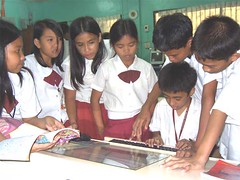
A recent post on David Warlick's 2 Cents Worth blog pointed me in the direction of a recorded interview with a bunch of American teenagers about their Internet habits, which took place at the 2005 web 2.0 conference. I found it particularly interesting, as I realised that my own Internet habits were pretty similar to the teenagers. Here are some of the main points that struck me:
- teenagers spend a great deal of time on MySpace or similar social networks. I visit MySpace once daily, although don't spend as long on there as they do - but I'm using alternative spaces for similar activities.
- they are really into IM, via whatever interface is used by most of their friends. I only recently managed to get off IM (mainly to save myself time, as I often got into distracting conversations in the middle of the day), although in a previous job I used IM extensively to chat with web developers
- they don't want to pay for things, and use P2P networks on a regular basis. Me too!
My conclusion is that we need to look more into the following areas in education:
- Internet safety for teens: how to protect them through education and media literacy
- IM for education: there are obvious applications in language teaching (linking up pairs of students across borders to chat in second languages) but how else could it be used?
- P2P educational resources: in education, we often say that we want teachers to share resources, but still put up barriers to students doing this. Shouldn't we allow students to share/learn from each other in this way too?

1 comment:
Thanks for your posting on my edublogs account today.
You are absolutely right about your conclusions.
I start teaching Internet safety for students as young as 8 due to the fact they are more likely to hear the message.
IM could be used in a homework help line with a teacher. The teacher starts up an IM session and the students can pop in to get their help. The teacher then could post the transcript for everyone in the class to benefit from in the future.
Barriers to P2P student resources are usually put help because of the lack of ethics in ownership. This is the biggest battle educators will have in the early 21st century until we adopt the "machinema" mentality that kids use now.
Keep fighting the good fight with your students!
Post a Comment